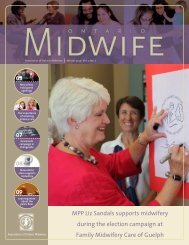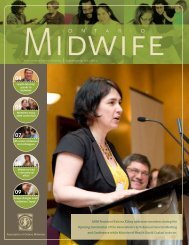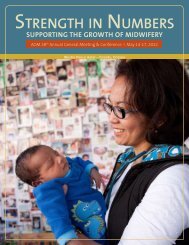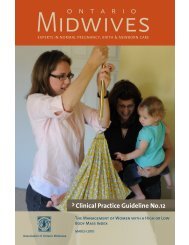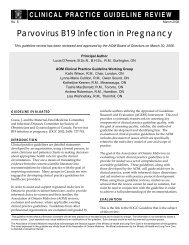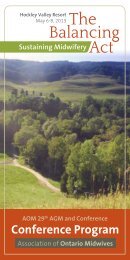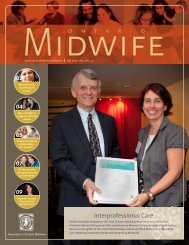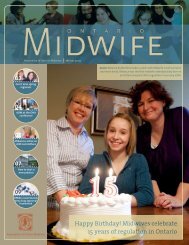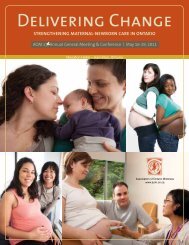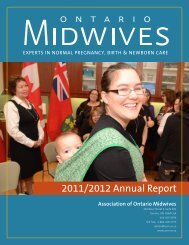Fall 2012 - Ontario Midwives
Fall 2012 - Ontario Midwives
Fall 2012 - Ontario Midwives
- No tags were found...
Create successful ePaper yourself
Turn your PDF publications into a flip-book with our unique Google optimized e-Paper software.
The Place TheyWill Be BornFor one-week old Oren and one-monthold Isaac, the big purple house atthe end of a long driveway on SourSprings Road is a place to sleep, eatand be cuddled by their loving parentsand grandparents and the adoringmidwives who welcomed them intothe world. It will be years before thetwo babies understand the significanceof being caught by Aboriginalmidwives, members of their owncommunity who recognize birth as asacred ceremony and provide prenatal,labour and delivery and postpartumcare by blending expert clinical skillsand First Nations’ knowledge andtraditions. For the babies’ parents andthe staff who work at the Maternaland Child Centre in Hagersville, avillage on the Six Nations of the GrandRiver reserve, near Brantford, <strong>Ontario</strong>,Oren and Isaac symbolize the return ofbirth to the community and the health,healing and pride that come with it.Before the centre opened in May1996, giving birth in hospital withnon-Aboriginal health care professionalswas the only option for mostSix Nations families. There were onlya few midwives left in the communityand, due to their advancing ages, theywere only able to deliver the babies oftheir relatives.“We were losing our midwifery traditionsaround birth so this centre was arevival,” says Julie Wilson, an Aboriginalmidwife who is the supervisor of boththe Maternal and Child Centre and theAboriginal Midwifery Training Programat Six Nations. “The purpose was tobring birth back and to embrace allthe knowledge and traditions andcelebrate our uniqueness and how webirth. It also came out of a need and animportance we placed on having ourbabies on our territory so that they’retrue citizens of our territory.”Six Nations is the largest First Nationin Canada and the only territory inNorth Americawhere the SixIroquois nations— Mohawk,Cayuga,Onondaga,Oneida, Senecaand Tuscarora— live together.Of the total 24,000 band members,about half live in the territory. The signoutside the Birthing Centre reflects thehonour and responsibility of bringingnew life into the world in two Indigenouslanguages. TSI NON: WE IONNA-KERATSTHA means ‘The Place They WillBe Born’ in Mohawk. ONA: GRAHSTA isCayuga for ‘A Birthing Place.’The Birthing Centre has all the“We were losing our midwifery traditionsaround birth so this centre was a revival.”Julie Wilson, Aboriginal midwife andMaternal and Child Centre Supervisormedical equipment you would findin a small community hospital, but itlooks and feels like a spacious familyhome. The three comfortable birthingrooms have four poster pine beds, cozycomforters and private bathrooms.A bulletin board features photos ofbabies whose births the midwiveshave attended. Prints by Indigenousartists decoratethe other walls.There is a basketof toys in thefamily room, andthe welcomingkitchen is theperfect place todrink tea whilewaiting for babies to arrive. If you lookclosely, you will notice that there’sa small room with an examinationtable, speculums and a blood pressuremeter; and the storage room is filledwith oxygen canisters, gauze andother medical supplies. However, it’sthe building’s warm, homey feelingthat is most striking.Last year, the midwives at Six Nations(From left to right) <strong>Midwives</strong> Sharon Smoke; Julie Wilson, supervisor of the Birthing Centre and Aboriginal Midwifery Training Program at Six Nations; Kristi Shawana;Phyllis Hill and student Melodie Smith. (Not pictured: midwife Laurie Jacobs)
Six-year-old Elijah kisses his one-week-old brother Oren as mom Stephanie Courtney looks on. Dad Chris Courtney holds Ezrah, 2.attended 100 births. Half the babieswere born in the three spacious andcomfortable birthing rooms in theBirthing Centre. The others were bornin their own homes. Eighty per centof the midwives’ clients are from SixNations and surrounding area, but theother 20 per cent live in the Niagararegion or citieslike Hamilton,Fort Erie andLondon. Wilsonsays Londonis the farthestsouth that themidwives willtravel for a home birth and, due tothe distance, clients from that cityneed to travel to the centre for theirpostpartum visits.Midwife Sharon Smoke understandswhy women are willing to drive fromLondon to Six Nations to have appointmentswith an Aboriginal midwife. Aspart of her midwifery education, shespent a year at Maternidad La Luz, acommunity-based birth centre andmidwifery school in El Paso, Texas thatserves mostly Mexican and Mexican-American clients. While she enjoyedcaring for the Spanish-speakingwomen she regretted that she couldn’tprovide culturally-appropriate care intheir own language.“I could identify with how they musthave felt being in that position of nothaving their own people look afterthem,” says Smoke. “And that’s how itis for us when we have other peoplelooking after our health needs.”Today Smoke delights in working“I didn’t feel like I had much of a voicewith my other pregnancies and I wasreally happy to have that back.”Stephanie Courtney, midwifery clientwith her own people and says beingconnected to her clients throughculture enables her to provide the kindof midwifery care that she couldn’tin El Paso. Some of her clients at SixNations are aware of their families’traditions around pregnancy and birth,but for others it may be their firstopportunity to learnabout them. She saysshe’s happy to shareher own beliefs withcouples, but thinksit’s more importantto encourage them toask their parents andgrandparents about family history andknowledge.Baby Oren’s mother, Six Nationsclient Stephanie Courtney, learnedabout traditional medicines from herfamily and experienced the benefitsof drinking traditional teas when shewas pregnant with Ezrah (now almost2) and Oren. She had gestationaldiabetes while carrying her first child,Elijah (6), who was born under the careof an obstetrician, but drank the teasduring the other two pregnancies anddidn’t have any symptoms.Courtney and her husband Chrisnoticed other marked differencesbetween midwifery and obstetricalcare. After having two miscarriages,she says she came to the BirthingCentre because she wanted a stressfreesituation where she could makeher own choices.“I didn’t feel like I had much of a voicewith my other pregnancies and I wasreally happy to have that back,” she says.When Elijah was born in hospital, Chrisremembers being told to leave whenvisiting hours were over. In contrast,Oren was born at home and his momhad the support of her partner andher entire family. Stephanie’s motherand Chris were her labour coaches andher sisters came into the room whenshe was pushing. Nine other relativeswaited in the living room for the babyto arrive.“It was awesome,” says Chris. “It was soconvenient, so relaxing and so peaceful.Everything’s right there and you’re inthe comfort of your own home.”The Vyse family is also grateful that themidwives at Six Nations ensured thatthe arrival of their newest memberwas a ceremony and celebrationfor the whole family. Baby Isaac’sgrandmother Debra Vyse says seeingher grandson being born gave her anopportunity to witness the miracleof birth in a way that wasn’t possiblewhen she had her own children.“It was one of the most wonderfulexperiences I’ve had in my life,” Vysesays of watching her daughter-inlawCarly give birth. “It was a totallyamazing feeling to see Carly do it.Right after she had him, I said ‘Carly,you’re my new hero.’ It seemed likewe were all part of bringing him here.I wish every grandparent could havethat experience.”Carly Vyse is currently on maternityleave from the centre where she isthe Fetal Alcohol Spectrum Disorderand Child Nutrition Coordinator. Shesays she appreciated the support andwww.aom.on.ca 5
encouragement her midwives providedthroughout her labour and delivery,and the education they gave the entirefamily, including a special visit to letthem know what medical equipmentthe midwives would bring to the homeand how things like oxygen would beused, if necessary.“I feel like I know so much aboutlabour and childbirth and postpartum,”says Vyse. “ I don’t think I would havegotten that education in the hospital.The midwives are so reassuring. Theysay ‘If at any time we see a situationwe’re not comfortable handling, thenwe’ll go to the hospital.’ So there are nofears the day of.”One of the peoplewho helpedalleviate anyfears Vyse mayhave had was herstudent midwifeMelodie Smith, acolleague at thecentre and a student in the AboriginalMidwifery Training Program. Smith,one of the birthing centre’s earlyclients, says that when midwivescaught her son Ashton at home in1997 she knew that she wanted tobecome one of them. But she hadto put her dream on hold while sheraised her sons. Three years ago whenher boys were 8, 9 and 11, the singlemom started the educational programas a full-time student. Since then she’sdedicated herself to studying andattending births.Smith has learned about reproductiveanatomy and physiology, normal andabnormal birth, and topics like hypertension,gestational diabetes andfetal circulation through an intensiveeducation program that includesself study, weekly tutorials with herpreceptor and time spent observingprenatal and post partum visits andbirths. Her skills are evaluated throughregular written tests and all themidwives at the centre provide verbalfeedback on her progress. Six months“I feel like I know so much about labour andchildbirth and postpartum. I don’t think Iwould have gotten that education in thehospital. The midwives are so reassuring.”Carly Vyse, midwifery clientClient Carly Vyse stands outside the Maternal and Child Centre with her two-year-old daughter Madalyn,mother-in-law Debra Vyse and one-month-old son Isaac.into the program when she beganattending clinics, it was only a shortwalk from her desk to the centre’sexamination room. When she needs topractice drawing blood or inserting anIV, the midwivesare happy to lether practice onthem. Smith saysshe appreciatesthe individualizededucation she’sreceiving at thebirthing centreand the support ofall the midwives who’ve become likesisters to her.After years of being the first personto arrive at the centre every morningand the last one to leave each night,she’s now just eight births away fromthe 60 she needs to attend in orderto complete the program. She plansto graduate in December. Unlikeregistered midwives who completeone of the province’s three MEPprograms, Smith is unlikely to find afunded midwifery position when shegraduates. In order to use the skillsshe’s spent four years mastering, shewill need to wait for a colleague atthe centre to go on maternity leave orfor an Aboriginal midwife in anothercommunity to set up a practice.The program has been intense butSmith says the rewards make her hardwork worthwhile. She remembers thethrill she felt the first time someonecalled her their midwife and says shesmiles whenever she sees toddlers inthe centre’s Mom and Tots programwhose births she attended. “The biggestreward is seeing the numbers (ofbirths) grow at Six Nations and hearingpeople brag about their midwives, theirAboriginal midwives. We touch so manyfamilies’ lives,” says Smith.Smith admits that being a full-timemidwifery student while raising afamily requires a strong supportsystem. When her boys were youngershe couldn’t have balanced being oncall 24/7 with her school work andspending time with her kids withoutassistance from her mom and hersisters and the understanding of herchildren. Her youngest son has alwaystaken a great interest in her work.During her first year of study, everytime she came home from a birth heasked her ‘Was it a boy or a girl? Iseverything okay? Did she have to gothe hospital?’ These days he tells herthat when he gets married, he wantsher to deliver his children.Six Nations’ clients are very appreciativeof the postpartum care themidwives provide to newborns andmothers. Women who give birth atthe centre, or in their homes on thereserve, are also pleased to get anadditional postpartum home visitfrom maternity care worker JanetHomer on Day 2. Homer’s goal is toensure that new mothers get thesame kind of support that MelodieSmith’s family has given her. Sheusually brings lactation consultantStephanie MacDonald with her toanswer any questions women haveabout breastfeeding. It’s not the firsttime the moms have met Homer, who6ontario midwife • <strong>Fall</strong> <strong>2012</strong>
Left: Maternity Care Worker Janet Homer in one of the spacious and comfortable birthing rooms .Right: During prenatal classes, Mohawk elder Sakoieta’ Widrick shares parenting information, family advice for couples, and traditional knowledge with Birth Centre clients.initially introduces herself to themaround the 36th week of pregnancy.During her postpartum visit, shechecks the baby’s vital signs, makesan impression of his or her footprints(that the parents will later receivein a bag filled with other gifts) andgenerally makes sure that mom andbaby are doing well.If the new mom doesn’t have hermother, sister, grandmother or auntsaround to help, Homer will lend ahand anyway she can. If she noticesthat dirty dishes are piled up in thesink, she’ll offer to wash them whilethey chat. She’ll also give the mom anopportunity to take a shower if she’scomfortable having Homer watchher baby. Building relationships withclients and encouraging them tobe the best parents they can be areamong the most important and mostrewarding aspects of her role. She saysone of the highlights of her work is“seeing the love in that mom’s faceand knowing that she’s discoveringwho she is.”Homer also makes sure parents knowthat they aren’t alone; if they needhelp, she and the midwives and theother staff at the centre are there tosupport them. In addition to assistingnew parents at home, Homer plans andruns a dynamic Moms and Tots group atthe centre that features guest speakers,cooking classes and crafts. Guestspeakers have provided helpful informationon caring for baby and toddlerteeth and shopping with coupons,but Homer believes the most valuableaspect of the group is the chance formoms to talk and bond with eachother. While the centre’s “Den Mothers”Ginger White and Judy McNaughtoncare for their children, Homer fades intothe background and gives the mothersan opportunity to discuss child rearingdilemmas with one another and shareRediscovering traditions and valuesmakes clients proud to be Indigenouspeople in Canada, says JulieWilson; and bringing birth back to thecommunity has reunited families andgiven them a strong connection.ideas and advice.Solving some child rearing dilemmasrequires the wisdom of an elder.That’s why on some occasions Homerinvites member of the centre’s GrandparentsCommittee to chat with themoms. “Some women don’t have anelder to talk to so I bring in a coupleof grandparents to share their experiences,”says Homer. “It’s very casual.We make a pot of tea and they canask questions.”Sakoieta’ (He Wakes Them UpEarly) Widrick is a highly-respectedMohawk elder who shares traditionalknowledge related to pregnancy andparenting duringprenatal classes “Birth is such a sacred ceremony; it needs to beat Six Nations.held and embraced within the community.”The father of six,grandfather of21 and greatgrandfatherofJulie Wilson, Aboriginal midwife andMaternal and Child Centre Supervisorone is devotedto family life.“I was taught that when you havechildren, for the next 25 years yourresponsibility is those children. Whenthey choose a partner, you can take astep back; you’ve been relieved fromthe responsibility of being the primarycare giver and now you become like acounsellor,” says Widrick.Among the wisdom Widrick impartsduring classes are teachings thathelp young men prepare to be goodpartners. One of his importantmessages is that women are sacredbecause they have a life giving abilitythat men don’t.“And because of that we can neverstrike her physically, mentally oremotionally, with words or objects, ourhands or anything. When we toucha woman our hands are meant to bestroking, an extension of our heart,”says Widrick.“Having babies born in the communityhelps the community heal as a whole.You can’t take an important elementsuch as birth out of the community andexpect the community to be healthy.Birth is such a sacred ceremony; itneeds to be held and embraced withinthe community,” she says.Wilson hopes that in the future theAboriginal Midwifery Training Programwill be ableto graduatemore midwiveswho will startsimilar centresin their owncommunities.“I would likethis to become a model of excellencein the native community — a modelof how you can incorporate traditionand Western (medicine) in a way that’ssafe and effective and useful andworks for our people.”She would like to see other communities— especially small, fly-in ones —reap the tremendous benefits of havingtheir own midwives. With their skillsand knowledge, Aboriginal midwivesprovide care that includes breastfeedingsupport, running well-woman clinics,doing Pap smears, and educatingfamilies about fertility and birth control.If Wilson gets her wish, midwiferyprograms will be in place in otherAboriginal communities long beforethe Orens and Isaacs who live there areready to start their own families.www.aom.on.ca 7
Aboriginal MidwiferySeventh Generation <strong>Midwives</strong> Toronto:Serving urban Aboriginal clientsWhen Jennifer Johnson becamepregnant six years ago, her motherin-lawtold her about SeventhGeneration <strong>Midwives</strong> Toronto (SGMT)and made the phone call to set up herfirst appointment with an Aboriginalmidwife. Johnson, who is proud to bethe practice’s ninth client, says havingher son with Aboriginal midwives wasa great experience.“I felt so much more comfortable atSeventh Generation because it’s anAboriginal-focused practice and theywere so supportive of all my birthplans,” says Johnson.While she wasn’t able to have thehome birth the SGMT midwives helpedher plan, her whole family attendedher hospital birth. In addition to herpartner, Johnson’s sisters, cousin,grandparents, mother and motherin-lawwere with her at the hospitaland her mother-in-law sang songs towelcome the baby into the world.Johnson says the postpartum careshe received from the midwives was“phenomenal.” At the time, she wasliving a one hour and forty minutedrive from Toronto and the midwivesdrove to her home several timesduring a snowy February to allay herconcerns about breastfeeding.Today Johnson is the office managerat the practice and she is thrilled to seeother Aboriginal women receive thesame culturally-appropriate midwiferycare that she had. She says one of theunique features of SGMT is the factthat clients are offered a smudgingceremony at visits.<strong>Midwives</strong> at SGMT have beenproviding culturally-sensitive care toIndigenous families and guiding themon the sacred, healing journey of birthsince 2006. The practice, which islocated on a quiet, tree-lined street indowntown Toronto, provides care forfamilies of all kinds, but gives priorityto Aboriginal clients. Each year, 25 to30% of the practice’s clients are Indigenousfamilies. The midwives caredfor a total of 65 Aboriginal families in2011 and will exceed that number thisyear, as they’ve caredfor 75 Indigenousclients in the first sixmonths of <strong>2012</strong>.Sara Wolfe, theregistered Aboriginalmidwife whoco-founded thepractice, says SGMTwill never be too fullfor an Aboriginalclient. “Sometimesit’s been tricky andthere’s been someshuffling and weworked harderthan expected thatmonth, but we’vealways made thatspace available forAboriginal families,”says Wolfe.The odds are highthat an Aboriginalclient who comes toSGMT will receive carefrom an Aboriginal midwife. Five ofthe thirteen midwives in the practiceidentify as Aboriginal (and anothergrew up in an Aboriginal family), as doall of the administrative staff.A number of paths lead Indigenouswomen and their families to SGMT.Families may be referred to thepractice by former clients or may learnabout it while attending a prenatalclass being conducted by Wolfe or oneof her colleagues at Anishinabe HealthToronto, Toronto Council Fire NativeCultural Centre or the Native Women’sResource Centre. Some familiesare referred by frontline workers atcommunity organizations such asNative Child and Family Services ofToronto (NCFST). Wolfe says that byworking closely with NCFST to ensurethat referred clients have the supportand resources they need to care fortheir children, they have preventedmany babies from being removedfrom their families.Establishing and nurturing strongties with members of Toronto’sJennifer Johnson (left) first met midwife Sara Wolfe (right) when she was aclient of Seventh Generation <strong>Midwives</strong> Toronto. Today Johnson is officemanager at the practice Wolfe co-founded in 2006.Aboriginal community has alwaysbeen important for Wolfe and hercolleagues. When she was startingthe practice, Wolfe laid a strongfoundation for these importantrelationships by seeking advicefrom Cree elder Joanne Dallaire andAboriginal midwives Katsi Cookand Carol Couchie. Over the years,a number of elders have helpedthe midwives gain a greater understandingof cultural teachings relatedto the significance of the childbearingyear and have attended practicepicnics so they could meet andsocialize with clients.In order to gain the trust ofcommunity members – especiallythe mothers, aunts and grandmotherswhose advice young womenrespect – Wolfe says it’s importantfor the midwives to be visible in theAboriginal community.“People listen to their grannies inour community so they need to seeus at the pow-wows, at births and inwomen’s homes. They need to getto trust us,” says Wolfe. She and her8ontario midwife • <strong>Fall</strong> <strong>2012</strong>
Aboriginal MidwiferyWorking to return midwifery to Aboriginal communitiesWomen living in dozens of communitiesacross <strong>Ontario</strong> are able to accessmidwifery care through midwiferypractices funded by the <strong>Ontario</strong>Ministry of Health and Long-TermCare (MOHLTC). Aboriginal womenliving on reservations do not have thesame access to midwives. Six Nationsof the Grand River is the only reservecommunity that has a midwiferypractice. While the MOHLTC iscommitted to growing midwifery, itdoesn’t create positions for Aboriginalmidwives practicing under theexemption clause in the MidwiferyAct (as it does for registeredmidwives), and there is no mechanismin place to pay these midwives fortheir skills and expertise.In spite of these significant barriers topracticing, some Aboriginal midwivesare so committed to caring for theirown people that they are leadingcampaigns to bring midwifery backto their communities. For thesemidwives, advocating for changesto the health care system involvesresearch, community education,government relations, and the abilityto develop business plans and feasibilitystudies.Dorothy Green and Jasmine Benedictdidn’t learn their advocacy skills inmidwifery school, but they’re socommitted to having babies born ontheir territories that they’ve acquiredthem along the way. Their hard work isstarting to pay off as both women getcloser to making their visions a reality.When Dorothy Green graduated fromthe four-year Aboriginal MidwiferyTraining Program at Six Nationsin August 2011, there wasn’t a jobwaiting for her. So she went to theemployment office in her reservecommunity of Tyendinaga, locatedon the Bay of Quinte in southeastern<strong>Ontario</strong>, and secured funding towork at Six Nations for six monthsas an apprentice midwife. When thecontract ended, Green returned toTyendinaga to continue leading thecampaign for an Aboriginal birthingcentre that she started in 2010.Green firmly believes that babiesshould be born on their territory.A few years agoshe uncovered anancestral link tothat belief when shediscovered that bothher great grandmothershad beenmidwives. Her passionfor returning birthto the TyendinagaMohawk Territory ledher to leave a 22-yearcareer with the Federalgovernment to studyat Six Nations. Duringthe intensive program,Green only had threedays off a month (andone month’s vacationeach summer), butspent most of her timeoff in Tyendinaga,conducting prenatalclasses and attendingcommunity eventsso she could talk topeople about bringingbirth back to thecommunity.When she surveyed citizens to gettheir opinions on having a birthingcentre in Tyendinaga, 100% ofthe men whoresponded and98% of thewomen werein favour of theplan.“It’s spiritual andit’s a communityevent when these little ones come intothe world and you want to share thatand celebrate it,” says Green.She says her desire to bring birth backto Tyendinaga is being fuelled by aneven higher purpose than spiritualityand celebration. “It’s to sustain whowe are as a people. To bring theseteachings back and to not lose trackof who we are and why we’re here,”says Green.Aboriginal midwife Jasmine Benedictgrew up in Akwesasne, a MohawkNation that is unique because theterritory straddles borders internationally(Canada and UnitedAboriginal Midwife Dorothy Green holds Keely Awenhakenhtha Maracle,her fifth granddaughter and tenth grandchild.“It’s to sustain who we are as a people. Tobring these teachings back and to not losetrack of who we are and why we’re here.”Dorothy Green, Aboriginal MidwifeStates) and provincially (<strong>Ontario</strong> andQuebec) on both banks of the SaintLawrence River. Benedict graduatedfrom the Birthwise Midwifery School,an accreditedinstitution inBridgton, Maine,in 2007, anddiscovered therewas no fundingfor her to practicemidwifery inAkwesasne. Sinceshe graduated, she has attended thebirths of Maori babies in New Zealandand Amish and Mennonite babies inthe United States, but finding a wayto provide care to her own people hasbeen much more challenging.“I came home to practice with mypeople here, and there are so manybarriers to doing that,” says Benedict.“It’s sad and it’s discouraging and I getreally frustrated…There’s a barrier interms of funding and it’s like we’re setup to fail…It’s not fair. It’s an inequity.”Benedict wants to establish anAboriginal birthing centre to serve12ontario midwife • <strong>Fall</strong> <strong>2012</strong>
16ontario midwife • <strong>Fall</strong> <strong>2012</strong>




